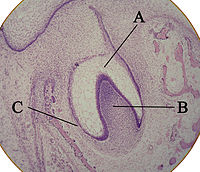
Photo from wikipedia
OBJECTIVE It aims to explore the effect of dental follicle cells derived small extracellular vesicles (D-sEV) with or without lipopolysaccharides (LPS) pretreating on the pathogenicity of Porphyromonas gingivalis (P. gingivalis).… Click to show full abstract
OBJECTIVE It aims to explore the effect of dental follicle cells derived small extracellular vesicles (D-sEV) with or without lipopolysaccharides (LPS) pretreating on the pathogenicity of Porphyromonas gingivalis (P. gingivalis). METHODS The antibacterial effects of D-sEV were evaluated by measuring the growth, biofilm formation, gingipains and type IX secretion system (T9SS) expression of P. gingivalis. And the influence of D-sEV on P. gingivalis adhesion, invasion, cytotoxicity, and host immune response was examined in gingival epithelial cells (GECs). Then P. gingivalis treated with D-sEV was applied to investigate the pathogenicity in experimental periodontitis of mice. RESULTS It showed that both D-sEV and P. gingivalis LPS pretreated D-sEV (L-D-sEV) could target P. gingivalis, inhibit their growth and biofilm formation, and hinder the attachment and invasion in GECs, therefore remarkably decreasing P. gingivalis cytotoxicity and the expression of IL-1β and IL-6 in GECs. In addition, they significantly reduced the expression of P. gingivalis virulence factors (gingipains and T9SS). In vivo, it showed that the bacteria in the gingiva were significantly decreased after sEV treatment. Meanwhile, less bone loss and fewer inflammatory cells infiltration and osteoclast formation in D-sEV and L-D-sEV groups. CONCLUSION Both D-sEV and L-D-sEV were proven to inhibit the pathogenicity of P.gingivalis and thus prevented the development of periodontitis.
Journal Title: Oral diseases
Year Published: 2022
Link to full text (if available)
Share on Social Media: Sign Up to like & get
recommendations!